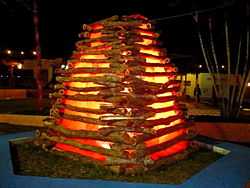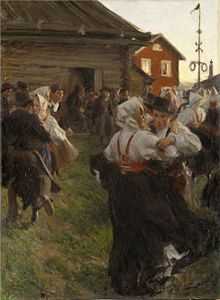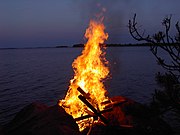Jāņi
Jāņi is a Latvian anniversary festival, which celebrates the summer solstice, the day when it has the shortest night and the longest day. Although the shortest night is usually on 21st or 22 June, the public holiday is on 23rd and 24 June. The day before Jāņi is called Herbal Day. On Jāņi Eve people go to gather flowers, from which women made wreaths and put on the heads. Men's wreath is usually made of oak leaves. Līgo songs are associated with fertility and disaster prevention.[1]
Traditions


Picking Herbs of Jāņi, house and fence decoration
Almost all herbaceous plants belonged to Herbs of Jāņi, but in particular people collected bedstraw, matricaria, vetchling, clover, etc. They embellished rooms, walls, courtyards, wreaths and crowns. Among trees, the most used decorations were birch boughs and oak branches. Houses were never decorated with aspen and alder twigs: they were considered to be evil trees.[2] Some Herbs of Jāņi were reaped on noon, others on Jāņi Eve, or on Jāņi morning when it had dew. According to P. Einhorn in 1627, he wrote that "Jāņi Day is given the power and sanctity of the herbs and its daily gathering, and has great and excellent properties against fires, people's and livestock's evil plagues and diseases".[3] The gate and every doors were tied with rowan, oak or birch boughs. Both in the rooms, the garner and the barn, boughs were placed and behinds of ceiling joists were occluded with broken oak, rowan and linden branches. To repel evil spirits and witches, people used thorns, thistles and nettles. Herbs of Jāņi were subsequently dried up and during winter or spring were given to cows shortly after calving. On Herb Day, the picked herbs were used to make a tea and were given to sick people and livestock. On Jāņi, picked rowan twigs were tied for cleaning, drying and were used for child's fumigation, when it was sick, afraid, or afflicted by an evil eye.
Jāņi crown wreathing

Crown circle, as well as Jāņi cheese and Fire of Jāņi symbolized the sun. To wreath a crown a variety of flowers and oak leaves are used. It is believed, that crowns braided with twenty seven flowers and herbs prevents disasters and diseases, and repels envious people and foes. Oak wreaths were given to boys and the landlord, as they promised the blessing of horses and bees.
Burning Fire of Jāņi
Burning Fire of Jāņi (also known as pūdeļa, pundeļa, Jāņi candles, and witch burning) from sunset till next morning is related to the beliefs of the light transmission to the next solar year. Fire must be burning at the territory of the highest point, a tar barrel or a tarred wheel pole can also be used instead. Fire of Jāņi shine on fields and people are believed to acquire power and fertility.
Singing songs
Singing Līgo songs or Jāņi songs is associated with fertility and disaster prevention. The time of singing Ligo songs began two weeks before Jāņi, its highest point reached Jāņi Eve and lasted until Peter or Māras Day. After that they could no longer sing Līgo songs.[4] Singing Ligo songs on Jāņi night began after dinner and continued throughout the night until the sun rises, either during jumping over Fire of Jāņi, or while going from houses to houses. Singing visits on Jāņi were called aplīgošana. Servants were making such visits to their masters and owners, while maidens did it to guys and vice versa.
On Jāņi Day people drank beer and ate cheese, believing that it would help next summer to grow barley and make cows give more milk. Also, singing visitors from neighboring houses were treated both with cheese, and with beer.
Jāņi Night's spells
There is a belief that on Jāņi morning, milk witches were running on dew and shouted: "Everything to me, everything to me!" If anyone heard it, they must respond with: "I butchered half of them!" Then there would be no shortage of milk.[5] Witches dressed in white robes and let their hair loose on Jāņi, to make them look like normal women, so they could carry out spells in neighboring fields and livestock feedlot, belonging to those whom they wanted to damage and take away blessing.
Search for fern flower
It was believed that whoever finds a fern flower, were able to gain wealth and happiness, and find out the secrets of the past and future. "Whoever acquires the fern flower will be happy, because it can make anything they want to come true. The flower is hindered by evil spirits and only a brave person can get it".[6] "On Jāņi Eve, jump 8 times while on a broom handle around 8, which is hoisted on the ground. At that time do not talk and do not laugh. Once you have done so, then on the broom shaft astride hop to the nearest fern patch, but only on your own: then you will see the blossoming of fern flower".[7]
Jāņi Night's broad-mindedness
Women and young maidens made wreaths on the heads and all sang together, danced, and went to play roundelays. It is believed, that erotic activities can have positive impact on the creation of power.
Similar festive celebration traditions worldwide

Celebration of summer solstice is an ancient tradition of European people, it was especially preserved in Northern Europeans countries - Denmark, Estonia, Latvia, Lithuania, Norway, Finland, Sweden, but also Canada (especially in Quebec), Ireland and in some parts of United Kingdom (Cornwall) and USA. Ancient solstice festive remnants are also found in some Belorussian, Ukrainian, Polish, French, Italian, Maltese, Portuguese and Spanish folk traditions.
Names in Baltic Sea Countries
- Denmark - Sankthans
- Estonia - Jaanipäev
- Latvia - Jāņi, Zāļu diena, Līgo
- Lithuania - Joninės, Rasos, Rasa, Rasos šventė, Kupolės, Saulės, Krešės, Vidurvasaris
- Norway - Jonsok, sankthans, jonsvaka, jonsmesse
- Finland - Juhannus
- Germany - Johanni, Johannisnacht, Mittsommernacht
- Sweden - Midsommar (also known as Den helige Johannes Döparens dag)
Names in Slavic speaking countries

In some Slavic languages, solstice festive celebration traditions remained to be called after pagan god's name - Kupala (Купало, Купа́йло):
- Belarus - Купальле
- Bulgaria - Еньовден
- Croatia - Ivanjski krijesovi
- Russia - ночь Ивана Купалы (Иван Купала)
- Poland - Noc Kupały
- Ukraine - Іван Купала
Names in Romani speaking countries
- Asturias - Foguera de San Xuan
- Galicia - Hogueras de San Juan
- France - Fête de la Saint-Jean
- Catalonia - Nit de Sant Joan
- Portugal - Festa junina
Basque Country
- Basque Country - Donibane jaia
-
Jāņi bonfire in Sweden.
-

Jumping over a bonfire in Galicia.
-

Jumping over Fire of Jāņi in Poland.
-

Stuffed witch burning in Denmark.
-

Issued stamp in honor of Latvian Ligo festival (USSR, 1991).
-

Dance-singing on Jāņi Eve in Sweden (A.Corna painting, 1897).
-

Walking around the solstice tree in Sweden.
-

Issued stamp in honor of Belorussian Ivana Kupala festival (USSR, 1991).
Literature
- O. Līdeks. Latvian festival. Riga, 1940.
- P. Schmidt Latvian folk beliefs. Riga, 1940-1941.
- E. Olupe. Latvian anniversary customs. Riga, 1992.
- Latvian folk songs Vol. IV Riga, 1982.
External links
- Latvian folk songs about Jāņi celebration (Latvian)
- Jāņi celebration descriptions „Latvian Dainas” (Latvian)
- Latvian Jāņi songs (Latvian)
- Jāņi symbols (English)
- Austris Grasis. Reflections on Jāņi (Latvian)
- Latvian traditional seasonal rhythms (Latvian)
- Traditional solstice rituals in Turaida - 360° virtual tour | Virtual Latvia (Latvian)
References
- ↑ Jāņi, Jāņi is now here!
- ↑ B. Riekstiņš, "Recreation" 1932, 17. VI, 22.
- ↑ Paul Einhorn. "Idolatry and superstition refutation", 1627. Quoted from: Peter Schmidt. Latvian folk beliefs. Riga, 1940-1941.
- ↑ D. Ozolins, Jaunroze. From: Peter Schmidt. Latvian folk beliefs. Riga, 1940-1941.
- ↑ A. Zalite, Bērzpils. From: Peter Schmidt. Latvian folk beliefs. Riga, 1940-1941.
- ↑ B. Riekstiņš, "Recreation", 1932, 17. VI, 22.
- ↑ L. Aizupe, Irlava. From: Peter Schmidt. Latvian folk beliefs. Riga, 1940-1941.
| ||||||
